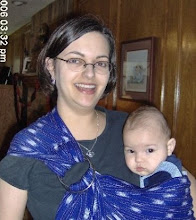An
excellent editorital from
OhmyNews International titled
C-Sections, Breastfeeding and Bugs For Your Baby. The author (who, by the way, could use a good copyeditor) writes:
The intestine of the unborn fetus in the mother's womb is sterile, devoid of any bacteria at all. However, during vaginal delivery the newborn comes in contact with bacteria-rich vaginal and fecal matter of the mother. These bacteria quickly invade and populate the newborn child. Saving of umbilical cords and the creepy ritual of eating the mother's placenta aside, this cycle links the co-evolution of intestinal "microflora" of the mother to child, and may represent a more significant bond for those who understand it exist. This evolutionary bacterial right of passage has been and continues to be critical to the success of our species, and all mammals for that matter.
A child born through c-section essentially skips this critical evolutionary process. Though a c-section baby does receive bacteria from the mother, it's not the diverse and dense "base population" that it would have received from the vaginal fluids and fecal matter via a traditional birth. In either birthing method, the baby is subject to all the bacteria in the room -- that even means the weird looking rubber-gloved fellow in the corner -- who appears to be assisting the delivery staff in some way. But who can be sure?
And then on to breastfeeding:
Breast-feeding newborns, like the evolutionary process of vaginal birth, is about bacteria. The breast milk of a human mother, like other mammalian mothers, is species-specific, having been adapted over eons to deliver specific and sufficient nutrition to guarantee proper growth, health, and immunity development. Researchers have long known that breast-fed babies possess an intestinal flora that is measurably different than formula-fed infants. Of specific interest is a group of bacteria known as bifidobacterium. Some of you may immediately recognize the name, as they are often added to dairy-based foods such as yogurt, often advertised as "live cultures" on the packaging. These are probiotics.
Studies have shown that at one month of age, both breast-fed and formula-fed infants possess bifidobacterium, but population densities in bottle-fed infants is one-tenth that of breast-fed infants. The presence of a healthy and robust population of bifidobacterium throughout the first year or two of life contributes significantly to the child's resistance to infection and overall development of defense systems -- not to mention the physical development of the intestinal system in general. Aside from the substances secreted by these specific bacteria that are known inhibit the growth of pathogenic bacteria, they also work to make the intestinal environment of the infant more acidic, creating an additional barrier against invading pathogens. In short, breast-fed babies are sick less, are less fussy, have fewer and shorter duration of bouts of diarrhea, and have more frequent -- and softer -- bowel movements.
One commentor corrected Mr. Leach's language - it's not that breast-fed babies are sick
less, are
less fussy, and have
fewer and
shorter duration of bouts of diarrhea - it's that babies fed artificial baby milk are sick
more, are
more fussy, and have
more and
longer duration of bouts of diarrhea.
Watch your language! The dominance of health-giving bifidobacterium in breast-fed babies is due the presence of special carbohydrates in mother's milk known as oligosacchrides. These special carbohydrates are virtually absent in cow's milk. From a physiological point, these special carbohydrates escape digestion and absorption in the small intestine of the infant, and thus reach the colon intact -- where they serve as food for, among other bacteria, the all-important bifidobacterium. As the bacteria thrive on this "food" from mother's milk, they grow in number and absorb water, resulting in more regular and soft bowel movements. It's important to know that the bulk of infant feces are made up of live and kicking bacteria. Look next time if you don't believe me!
Yeah, thanks for that reminder. And here's the "take-home":
In the dozens of doctor visits my then wife and I made during pregnancy, and through two births, never once did the doctor or any other person involved tell us what I just told you. In all of the "how to be a new parent" and "how to take care of your new baby" books we read, not one detailed reference to the critical passing of mother's microflora to the child via the birth canal or the importance of feeding bifidobacterium, was ever provided.




No comments:
Post a Comment